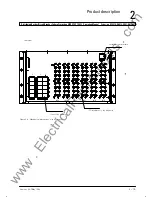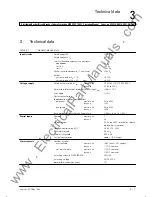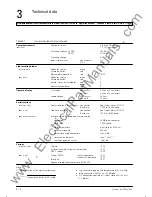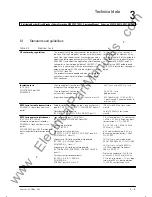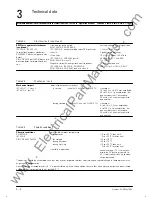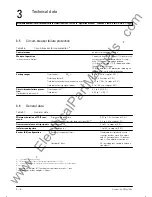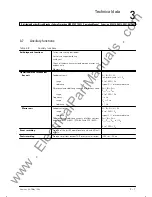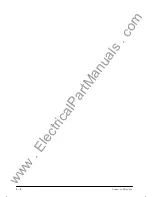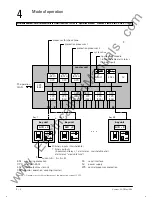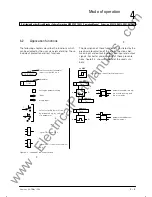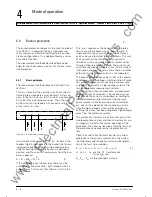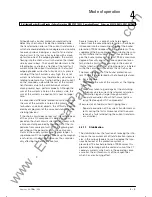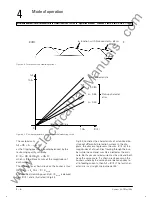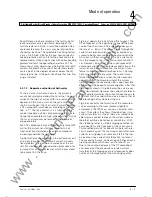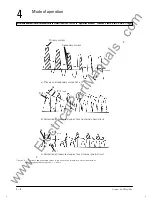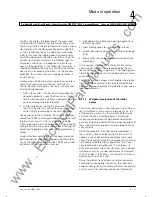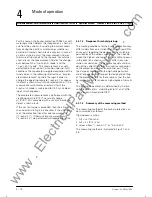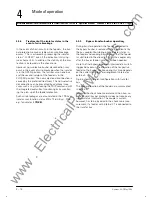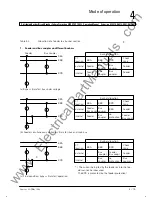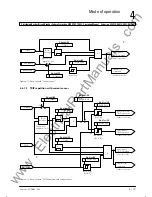
'(& )( )'& &) ( &!& ")& &$(( $#
Ć
%&( $# #)" &&#$
4 - 5
Siemens AG
⋅
May 1998
Although such a busbar protection would certainly
detect any short-circuit inside the protection zone,
the transformation errors of the current transformers,
which areunavoidableto somedegree, arealso liable
to cause spurious tripping as a result of an external
short-circuit. In that case, for instance with a close-
up fault on one of the outgoing feeders, the current
flowing into the short-circuit is shared on the infeed
side by several bays. The current transformers in the
infeeding bays carry only a fraction of the total fault
current while the current transformer in the faulted
outgoing feeder carries the full current in its primary
winding. If the fault current is very high, this set of
current transformers may therefore be saturated, so
tending to deliver only a fraction of the actual current
on the secondary sidewhiletherest of thecurrent
transformers, dueto thedistribution of currents
among several bays, perform properly. Although the
sum of the currents is zero on the primary side, the
sum of the currents in equation (2) is now no longer
zero.
In conventional differential protection systems where
thesum of thecurrents is zero on theprimary side,
for busbars and similar objects, this difficulty is countĆ
ered by employment of the so-called stabilization (reĆ
straining) devices.
If theshort-circuit does not occur at thevoltagepeak
of the cycle, a DC component is initially superimĆ
posed on the short-circuit current which decays with
a timeconstant governed by theratio L/R of theimĆ
pedancefrom sourceto fault. With thegrowing outĆ
put ratings of the generator units, these time conĆ
stants in the supply system tend to grow longer. A
superimposed DC component speeds up the magnetĆ
ic saturation in the transformer cores, thus considerĆ
ably affecting the transformation task.
Several measures - some of which are already
known from the conventional protection - have been
introduced into the measuring system of the busbar
protection 7SS52 to cope with these problems. They
supplement thebasic principleof monitoring thesumĆ
mation (differential) current. It was thus possible to
givethebusbar protection system 7SS52 a maximum
degree of security against spurious operation for exĆ
ternal short-circuits while ensuring, in the event of
internal short-circuits, that a tripping signal is initiated
within the very short time of less than a half-cycle.
Themeasuring circuit of thebusbar protection sysĆ
tem 7SS52 is characterized by the following features:
D
Basic principle:
Monitoring thesum of thecurrents as thetripping
quantity
D
Measures taken to guard against the disturbing
influences due to current-transformer saturation:
1. Stabilization (against largethrough currents)
2. Separate evaluation of each half-wave (particu-
larly effective against DC components)
Measures taken to obtain short tripping times:
Separate evaluation of the current transformer curĆ
rents during the first milliseconds after the occurĆ
renceof a fault (anticipating thecurrent transformĆ
er saturation).
Thestabilization has thefunction of reducing theinfluĆ
ence on the measurement of transformation inaccuraĆ
cies in the various feeders to such a degree that spuĆ
rious behaviour of the protection system is
prevented. The busbar protection 7SS52 solves this
problem by forming both the vectorial sum of the CT
seondary currents which acts in the operating sense
as well as the arithmetic sum of those quantities
which has a restraining effect.
www
. ElectricalPartManuals
. com
Summary of Contents for SIPROTEC 7SS52
Page 1: ... w w w E l e c t r i c a l P a r t M a n u a l s c o m ...
Page 2: ...w w w E l e c t r i c a l P a r t M a n u a l s c o m ...
Page 3: ... Siemens AG 1998 w w w E l e c t r i c a l P a r t M a n u a l s c o m ...
Page 6: ... w w w E l e c t r i c a l P a r t M a n u a l s c o m ...
Page 17: ... w w w E l e c t r i c a l P a r t M a n u a l s c o m ...
Page 33: ... w w w E l e c t r i c a l P a r t M a n u a l s c o m ...
Page 34: ... w w w E l e c t r i c a l P a r t M a n u a l s c o m ...
Page 35: ... w w w E l e c t r i c a l P a r t M a n u a l s c o m ...
Page 36: ... w w w E l e c t r i c a l P a r t M a n u a l s c o m ...
Page 44: ... w w w E l e c t r i c a l P a r t M a n u a l s c o m ...
Page 166: ... w w w E l e c t r i c a l P a r t M a n u a l s c o m ...
Page 168: ... w w w E l e c t r i c a l P a r t M a n u a l s c o m ...
Page 170: ... w w w E l e c t r i c a l P a r t M a n u a l s c o m ...
Page 184: ... 1 w w w E l e c t r i c a l P a r t M a n u a l s c o m ...
Page 186: ... w w w E l e c t r i c a l P a r t M a n u a l s c o m ...
Page 202: ... 0 0 0 w w w E l e c t r i c a l P a r t M a n u a l s c o m ...
Page 206: ... X w w w E l e c t r i c a l P a r t M a n u a l s c o m ...
Page 208: ...w w w E l e c t r i c a l P a r t M a n u a l s c o m ...
Page 209: ...w w w E l e c t r i c a l P a r t M a n u a l s c o m ...
Page 210: ... w w w E l e c t r i c a l P a r t M a n u a l s c o m ...

